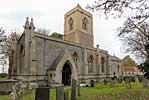For this church:    |
| ||||||||||||||||||
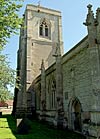 The tower and north The tower and northaisle from the north-west |
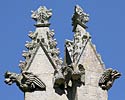 Decorated buttress Decorated buttresspinnacles on the west wall of the nave |
 Door in north wall Door in north wall |
 The south wall of The south wall of the nave |
Exterior
The angle-buttressed tower is of two stages and dates from the late 14th century. Much of the lower stage was rendered in 1936. The east wall of the tower has on the first floor a rectangular light with the date 1687 over it. Around the tower there is a corbel table with two gargoyles on each side.
Gill suggests that 'squinches' inside the tower prove that the builders originally intended to add a spire but this was never realised.
The buttresses on the north and west walls of the nave rise above the corbel table and terminate in decorated pinnacles.
The north wall of the north aisle has a doorway 'with foliate decorated capitals extending to imposts with ogee arch, finial and label stops over. Above is a niche with damaged base, and canopy decorated with crockets, cusping and 2 small heads.' It is possible the niche was once occupied by an image of St. Lawrence the Martyr as the aisle appears to have been built and dedicated in his honour.
There are three three-light windows in the south wall of the nave. They all have hoodmoulds and label stops; the window in the centre has flowing tracery and the windows on either side are reticulated with multifoils.
Interior
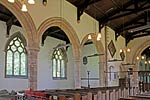 North arcade looking North arcade looking north-east |
 Chancel arch Chancel arch |
The 14th century north arcade consists of three bays and has octagonal piers with moulded capitals and bases supporting double-chamfered arches.
There is a triple chamfered tower arch which is blocked, presumably during the restoration of 1853-4.
The double chamfered chancel arch is supported on octagonal engaged columns with hood mould and label stops, with a traceried screen dating from 1519.
Medieval Cross Slabs
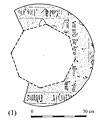 |
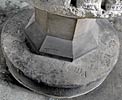 |
| Cross slab 1 (drawing by Peter Ryder) | |
 |
 |
| Cross slab 2 (drawing by Peter Ryder) | |
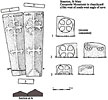 |
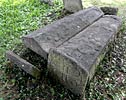 |
| Cross slab 3 (drawing by Peter Ryder) | |
(1) Part of a floor-stone cross slab re-used as the northern half of the circular step on which the font stands, so all that is visible is some sections of the border panel with its black-letter inscription, two additional lines of smaller (secondary) lettering that ran across the top of the slab within the border, and part of one terminal of the crosshead, a pointed bud and one rounded leaf. 15th or early 16th century.
(2) Intact slab now set at the north-east corner of the north aisle. A tapering slab, unusually thick (0.25m) which beats a lightly-incised cross paté rising from a base with rounded steps. The marginal inscription is presumably secondary and commemorates Sir William de Staunton son of Sir Maugher de Staunton who died on 31st May – the year is not recorded, but is thought to be c1250. A puzzling piece, as the stone is presumably of the 12th century, and the inscription is in black-letter, suggesting a 15th or 16th century date.
(3) A remarkable churchyard monument c 10m west of the south-west corner of the nave. It is a composite of five stones; two coped cross slabs are set on a low plinth of squared blocks and rubble; although perhaps of different dates (the southern is narrower and thinner) they bear near-identical relief designs, now very worn; each has a round-leaf bracelet cross rising from a stepped base, with midway up the shaft a pair of right-angled branches ending in buds and leaves. The cross heads are set a little short of the tip of the stone, allowing for a single transverse line of inscription, apparently in black letter, although now eroded beyond legibility. Once again, a puzzling combination of a stylistically-early cross form and what looks like a late medieval inscription. At the head of the slabs are a pair of upright headstones, with a single similar but smaller upright slab set centrally at the base. Each of these bears an incised design, a variant on a cross paté on the outer face, and a pair of smaller but similar crosses on the inner. Might these stones represent Sir Thomas Staunton d.1371 (and presumably his wife), who it is recorded wished to be buried in the churchyard (Cox, 201)?


